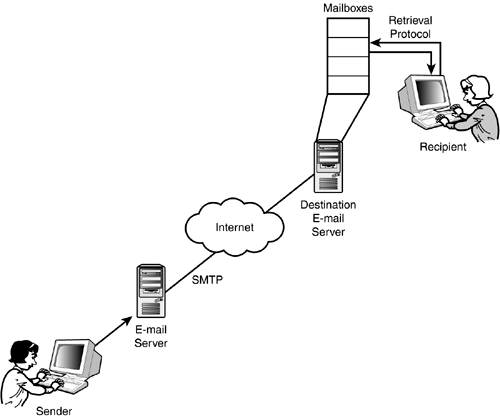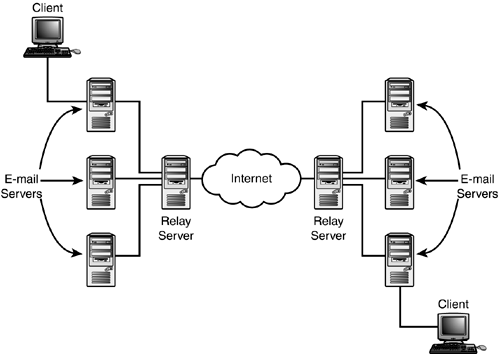How Email Works
| Like other Internet services, email is built around a client/server process. However, the email process is a bit more complicated. To put it briefly, the computers at both ends of the email transaction act as clients, and the message is passed across the network by servers in between. The email delivery process is shown in Figure 18.1. A client sends a message to an email server. The server reads the address of the intended recipient and forwards the message to another email server associated with the destination address. The message is stored on the destination email server in a mailbox. (A mailbox is similar to a folder or queue of incoming mail messages.) The user to whom the message is addressed occasionally logs on to the email server to check for mail messages. If incoming messages are waiting in the user's mailbox, the messages are downloaded to the user's computer. The user can then read, store, delete, forward, or reply to the email message. Figure 18.1. The email delivery process.
As you'll learn later in this hour, a client application called an email reader tends to the details of sending outgoing mail and logging on to the server to download incoming mail. Most users interact with the email process through the interface of an email reader. The process of sending a message and forwarding it between servers is managed by an email protocol called Simple Mail Transfer Protocol (SMTP). The email address gives the addressing information the server needs to forward the message. RFC 822 spells out the format of the ever more popular Internet email address format: user@server or (for example) BillyBob@Klondike.net SallyH@montecello.com cravenprof@harvard.edu In this standard format, the text after the @ symbol is the name of the destination email server. The text before the @ symbol is the name of the recipient's mailbox on the email server. By the Way In reality, the text after the @ symbol usually represents the domain name of the default email server on the recipient domain. The DNS servers for the domain hold an MX resource record that associates a mail server with the domain name. See Hour 11, "Name Resolution," for more on DNS. The format of the email address underscores an important observation about email on the Internet: The destination of an email message is not the recipient's computer but the recipient's mailbox on the email server. The final step of transferring waiting email messages from the email server to the computer of the recipient is really a separate process. You'll learn later in this hour that this final step is managed through a mail retrieval protocol such as Post Office Protocol (POP) or Internet Message Access Protocol (IMAP). Some networks use a hierarchy of email servers for more efficient delivery. In this scenario (see Figure 18.2), a local email server forwards messages to a relay email server. The relay email server then sends the mail to another relay server on the destination network, and this relay server sends the message to a local server associated with the recipient. Figure 18.2. Relay servers often add efficiency to the process of delivering mail.
|
EAN: 2147483647
Pages: 259

